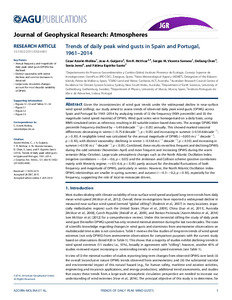Por favor, use este identificador para citar o enlazar este ítem:
http://hdl.handle.net/20.500.11765/11656
Trends of daily peak wind gusts in Spain and Portugal, 1961–2014
| Título : | Trends of daily peak wind gusts in Spain and Portugal, 1961–2014 |
| Autor : | Azorín Molina, César; Guijarro Pastor, José Antonio


|
| Palabras clave : | Daily peak wind gusts; Wind speed; Trends |
| Fecha de publicación : | 2016 |
| Editor: | American Geophysical Union |
| Citación : | Journal of Geophysical Research: Atmospheres. 2016, 121(3), p. 1059-1078 |
| Versión del editor: | https://dx.doi.org/10.1002/2015JD024485 |
| Resumen : | Given the inconsistencies of wind gust trends under the widespread decline in near-surface wind speed (stilling), our study aimed to assess trends of observed daily peak wind gusts (DPWG) across Spain and Portugal for 1961–2014 by analyzing trends of (i) the frequency (90th percentile) and (ii) the magnitude (wind speed maxima) of DPWG. Wind gust series were homogenized on a daily basis, using MM5-simulated series as reference, resulting in 80 suitable station-based data sets. The average DPWG 90th percentile frequency declined by _1.49 d decade_1 (p<0.05) annually. This showed marked seasonal differences: decreasing in winter (_0.75 d decade_1; p<0.05) and increasing in summer (+0.18 d decade_1; p>0.10). A negligible trend was calculated for the annual magnitude of DPWG (_0.005ms_1 decade_1; p>0.10), with distinct seasonality: declining in winter (_0.168ms_1 decade_1; p<0.10) and increasing in summer (+0.130ms_1 decade_1; p<0.05). Combined, these results reveal less frequent and declining DPWG during the cold semester (November–April) and more frequent and increasing DPWG during the warm semester (May–October). Large-scale atmospheric changes such as the North Atlantic Oscillation Index (negative correlations ~_0.4–_0.6; p<0.05) and the Jenkinson and Collison scheme (positive correlations mainly with Westerly regime: ~+0.5–0.6; p<0.05) partly account for the decadal fluctuations of both frequency and magnitude of DPWG, particularly in winter. However, the North Atlantic Oscillation index-DPWG relationships are smaller in spring, summer, and autumn (~_0.1–_0.2; p>0.10), especially for the frequency, suggesting the role of local-to-mesoscale drivers. |
| URI : | http://hdl.handle.net/20.500.11765/11656 |
| ISSN : | 2169-897X 2169-8996 |
| Colecciones: | Artículos científicos 2015-2018 |
Ficheros en este ítem:
| Fichero | Descripción | Tamaño | Formato | ||
|---|---|---|---|---|---|
| Azorin_daily_peak_jgr... | 3,33 MB | Adobe PDF |  Visualizar/Abrir |
Los ítems de Arcimis están protegidos por una Licencia Creative Commons, salvo que se indique lo contrario.





